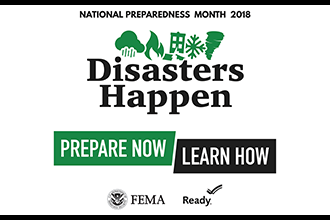Not only does Sept. 1 herald Labor Day Weekend – it kicks off National Preparedness Month. National Preparedness Month (NPM) is a call-to-action encouraging Americans to prepare for emergencies in their homes, businesses, schools and communities. This year’s theme is: Disasters Happen. Prepare Now. Learn How.
–>
ESA Encourages Small Businesses to Join in National Preparedness Month
Association Provides Tips to Help Small Businesses Integrate Security and Life Safety Systems into Preparedness Planning
Irving, Texas — Not only does Sept. 1 herald Labor Day Weekend – it kicks off National Preparedness Month. National Preparedness Month (NPM) is a call-to-action encouraging Americans to prepare for emergencies in their homes, businesses, schools and communities. This year’s theme is: Disasters Happen. Prepare Now. Learn How.
The Electronic Security Association (ESA) is joining in the NPM initiative by providing tips and guidelines to help small businesses learn how to integrate their security and life safety systems into preparedness planning.
“Many of our ESA members are small business owners who know first-hand the devastation a disaster can wreak on a business, its employees and their families. In 2017 alone, wildfires, hurricanes and other natural disasters cost more than $300 billion, according to Fortune Magazine,” says Chris Mosley, president of ESA. “We believe it is extremely important for small businesses to have a preparedness plan in place.”
In fact, 40 percent of small businesses don't reopen after a natural disaster due to the astronomical cost of repairing damages, according to the Federal Emergency Management Agency (FEMA).
“With extensive technologies on the market today, security systems can be configured with disaster detection sensors that can alert you to life-threatening conditions and enable you to take the appropriate action. This includes carbon monoxide leaks; an unusual rise in temperature that could signal a fire; a drop in temperature that could indicate a freeze condition; and rising indoor water levels caused by flooding,” Mosley says.
Below are more preparedness planning tips from ESA:
1. Know what types of emergencies are likely to happen in your geographic area – this includes all types of natural disasters such as hurricanes, tornadoes, wildfires, flooding, snow storms, extreme heat and extreme cold.
2. Include the contact information for your security provider on your business emergency contact list. This will make it easier to alert your provider if your company needs to evacuate or relocate. Use a secure, password-protected, web-based platform or app to store this information.
3. Make sure security passwords and passcodes are up-to-date and everyone with permission to access the property has memorized the passwords and codes.
4. Set up an emergency communications infrastructure for your business to relay crucial information to employees, customers and vendors, as well as facilitate business continuity.
5. Educate yourself and your employees so that everyone knows how to use the system to its full potential in case of an emergency. Additionally, sign up for your community’s warning systems and encourage your employees to do so.
6. Check with your security provider to understand how your system operates in the event of a power outage and how long it may be operable. Most systems have back-up batteries and will remain operational for a certain amount of time during a power failure, so make sure your batteries are in working order and appropriately charged. As a rule of thumb, optimum operation comes from batteries that were installed within three years and have not experienced multiple outages. However, it is always best to check with your security provider as they have the proper diagnostic tools to determine functionality.
Did You Know?
Security and surveillance systems can be connected to a back-up generator, so the systems continue to function once electrical power is out. Discuss this option with your security provider.
7. If you have a security system that is connected to your smart phone, make sure the app is properly installed on your phone. Through video and audio surveillance, you can monitor your property in real-time. If a power outage occurs, this feature may not work for the full duration of an emergency, but it can alert you to issues so you can start immediate repairs upon return. Again, consult with your security provider to determine if an uninterrupted power supply was installed that will provide battery backup on your cameras.
8. Consider new technologies, such as disaster detection sensors that can detect and alert you to life-threatening issues, including: carbon monoxide leaks, changes in temperature and flooding.
9. In addition to being a major cause of emergencies, fires are common in the aftermath of a natural disaster. Ensure your smoke detectors are working properly and are connected to your security and fire alarm system. One way to better prepare your business for a disaster is to use a security solution that includes instant alerts which can be sent directly to your smart phone. Both you and the monitoring station can be notified the moment your smoke detectors are activated. Video surveillance cameras within your business can be programmed to send a live feed from the area in which the sensor has been triggered. This real-time technology allows you to react quickly and keeps first responders current to events taking place on the property.
10. If you live in an area that is prone to evacuations and are concerned about vandalism, consider a professionally-installed and monitored security system. Through real-time audio and video surveillance, your security provider can verify the intrusion with local authorities, so they can prioritize and respond accordingly. More importantly, it frees you to focus on evacuating operations to a safe location.
“Although a security system may be the last thing on a business owner’s mind in the midst of an emergency, it is often a significant component of a business and should be included in preparedness plans,” says Mosley.
Need help determining how to integrate your security and life safety systems into your preparedness planning? Visit Alarm.Org to find an ESA member company in your community. All ESA member companies must adhere to a strict Code of Ethics and Standards of Conduct to ensure high quality work and services.
More information about National Preparedness Month and developing a business emergency plan can be found at Ready.gov.
–>
ABOUT ESA
Established in 1948, ESA is the largest trade association in the United States representing the electronic life safety and security industry. Member companies install, integrate and monitor intrusion and fire detection, video surveillance and electronic access control systems for commercial, residential, industrial and governmental clients. In cooperation with an alliance of chapter associations, ESA provides technical and management training, government advocacy and delivers information, advice, tools, and services that members use to grow their businesses and prosper. Together, ESA member companies employ more than 500,000 industry professionals and serve more than 34 million residential and commercial clients.www.ESAweb.org
–>
–>
–>
Copyright © 2018 Electronic Security Association, All rights reserved.




